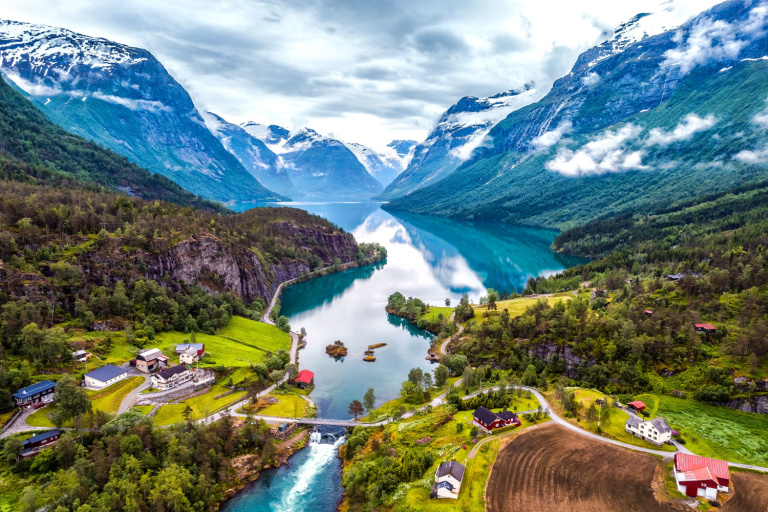
Smit/Shutterstock
When Is the Best Time to Visit Scandinavia?
The best time to visit Scandinavia is during the shoulder seasons of spring (April to June) and autumn (September to October). During these months, the weather is generally mild and sunny, with fewer crowds and lower prices than during the peak summer season.
Here are some of the benefits of visiting Scandinavia during the shoulder seasons:
- Mild weather: Scandinavia has a temperate climate, with mild summers and cool winters. The shoulder seasons offer pleasant temperatures, making them ideal for sightseeing, exploring, and enjoying the outdoors.
- Smaller crowds: The shoulder seasons are less crowded than the peak summer season, so you’ll be able to enjoy Scandinavia’s popular tourist attractions without having to deal with large crowds. This is especially important if you’re visiting popular destinations like the Geirangerfjord, the Lofoten Islands, and the Copenhagen Tivoli Gardens.
- Lower prices: Prices for flights, accommodation, and activities are generally lower during the shoulder seasons than during the peak summer season. This means you can save money on your trip without having to sacrifice quality.
Here are some specific examples of how you can enjoy the most of Scandinavia during the shoulder seasons:
- Spring (April to June): The weather in spring is typically sunny and mild, with occasional showers. This is a great time to visit for hiking in the Jotunheimen National Park, visiting the Nærøyfjord, and seeing the midnight sun in the Arctic Circle.
- Autumn (September to October): The weather in autumn is also typically sunny and mild, with occasional showers. This is a great time to visit for seeing the fall foliage, visiting the Bergen fish market, and seeing the northern lights in the Arctic Circle.
While there are many great times to visit Scandinavia, if you’re looking for the best weather and the most opportunities to enjoy the region’s outdoor activities, then we recommend visiting during the shoulder seasons of spring and autumn.
 Average Temperatures by Month
Average Temperatures by Month
|
Jan |
Feb |
Mar |
Apr |
May |
Jun |
Jul |
Aug |
Sep |
Oct |
Nov |
Dec |
| Fahrenheit |
30°
|
36°
|
45°
|
57°
|
67°
|
76°
|
80°
|
79°
|
70°
|
59°
|
45°
|
36°
|
| Celsius |
-1°
|
2°
|
7°
|
14°
|
19°
|
24°
|
27°
|
26°
|
21°
|
15°
|
7°
|
2°
|
Climate in Scandinavia
Summer Season in Scandinavia
Scandinavian summers are mild and pleasant, especially in the southern regions, with average temperatures ranging from 15°C to 25°C (59°F to 77°F). This season is characterized by long days, with the phenomenon of the Midnight Sun in the northern parts, providing extended daylight hours for outdoor activities like hiking, cycling, and exploring the region's natural beauty. Summers in Scandinavia are generally dry, but occasional rain showers can occur, especially in coastal areas.
Rainy Season in Scandinavia
While Scandinavia does not have a specific rainy season like tropical regions, rainfall is more frequent during the late summer and autumn months. The rain during this period can vary from light drizzles to heavier downpours, particularly in coastal and mountainous areas, contributing to the lushness of the landscapes.
Winter Season in Scandinavia
Winters in Scandinavia are cold and long, especially in the northern parts of Norway and Sweden, where subarctic conditions prevail. Temperatures often drop well below freezing, and snowfall is common, creating picturesque winter landscapes and offering opportunities for winter sports such as skiing and snowboarding. The coastal areas of Denmark and southern Sweden experience milder but still chilly winters. Winter also brings shorter days and, in the far north, the Polar Nights, where the sun does not rise above the horizon for several weeks.
Our Recommendations
| Destination |
Jan |
Feb |
Mar |
Apr |
May |
Jun |
Jul |
Aug |
Sep |
Oct |
Nov |
Dec |
| Scandinavia |
 |
 |
 |
 |
 |
 |
 |
 |
 |
 |
 |
 |






